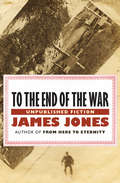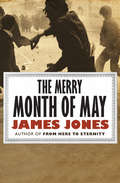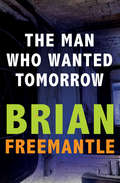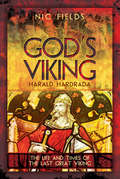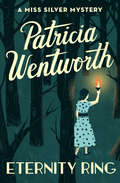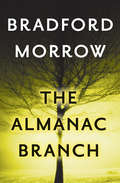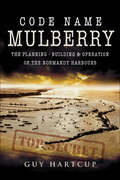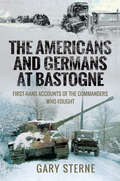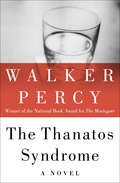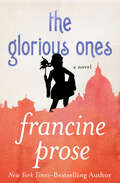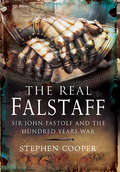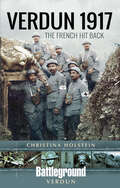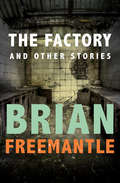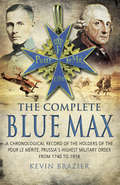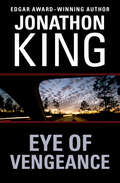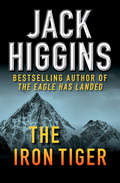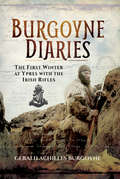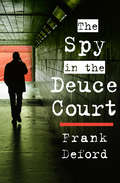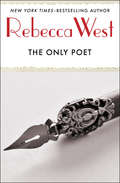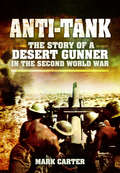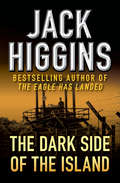- Table View
- List View
To the End of the War: Unpublished Fiction
by James JonesNever-before-published fiction by one of the finest war authors of the twentieth century In 1943, a young soldier named James Jones returned from the Pacific, lightly wounded and psychologically tormented by the horrors of Guadalcanal. When he was well enough to leave the hospital, he went AWOL rather than return to service, and began work on a novel of the World War II experience. Jones&’s AWOL period was brief, but he returned to the novel at war&’s end, bringing him to the attention of Maxwell Perkins, the legendary editor of Fitzgerald, Hemingway, and Thomas Wolfe. Jones would then go on to write From Here to Eternity, the National Book Award–winning novel that catapulted him into the ranks of the literary elite. Now, for the first time, Jones&’s earliest writings are presented here, as a collection of stories about man and war, a testament to the great artist he was about to become. This ebook features an illustrated biography of James Jones including rare photos from the author&’s estate.
The Merry Month of May
by James JonesA family of intellectuals comes apart at the seams during the 1968 student revolts in ParisThe Parisian student revolts of May 1968 shook the country—and the European continent—to its foundations. In a tradition-obsessed nation where the old-guard bourgeoisie had spent decades oppressing youthful unrest, every flavor of rage suddenly had a voice. Hill Gallagher is there—a brash young intellectual grown tired of pretending that the world doesn&’t make him angry. Despite the protests of his screenwriter father, he becomes involved in the movement, joining in on protests with the fervor of a man who isn&’t afraid to destroy his country—or his family. In The Merry Month of May, James Jones draws on his own experiences living in Paris and witnessing the 1968 revolts firsthand to create an unforgettable portrait of a society at war with itself—and torn apart by change. This ebook features an illustrated biography of James Jones including rare photos from the author&’s estate.
The Man Who Wanted Tomorrow
by Brian FreemantleA failed commando raid leads to a global hunt for the last remaining Nazi war criminalsSix Israeli commandos land on a lakeshore in Austria, hunting for something that has been hidden underwater for over thirty years. The lake holds many secrets left behind by the Nazi high command as their regime crumbled in 1945. There are millions of dollars in international currency, bonds, and gold bullion, but the commandos want none of it. They have come for boxes of files—containing information about the hiding places of every Nazi war criminal who evaded judgment at Nuremberg. But the commandos have been caught. Shotguns sing out, killing all but one of the Israelis. He escapes with one box, which holds nearly $2 million in gold but no information. The assassins recover two of the other boxes. A fourth is missing. Many men will die to find it—a price the Israeli secret service is willing to pay in the hope that justice may finally be served. This ebook features an illustrated biography of Brian Freemantle including rare photos from the author&’s personal collection.
God's Viking: The Life and Times of the Last Great Viking
by Nic FieldsAn epic historical biography of the Norwegian king who laid claim to the thrones of Denmark and England.Harald Hardrada is perhaps best known as the inheritor of “seven feet of English soil” in that year of fateful change, 1066. But Stamford Bridge was the terminal point of a warring career that spanned decades and continents. Thus, prior to forcibly occupying the Norwegian throne, Harald had an interesting (and lucrative) career in the Varangian Guard, and he remains unquestionably the most notable of all the Varangians who served the Byzantine emperors. In the latter employment he saw active service in the Aegean, Sicily, Italy, Anatolia, Syria, Palestine, and Bulgaria, while in Constantinople he was the hired muscle behind a palace revolution. A man of war, his reign in Norway was to be taken up with a wasteful, vicious, and ultimately futile conflict against Denmark, a kingdom (like England) he believed was his to rule. We follow Harald’s life from Stiklestad, where aged fifteen he fought alongside his half-brother, King Olaf, through his years as a mercenary in Russia and Byzantium, then back to Norway, ending with his death in battle in England.Praise for God’s Viking“A gripping story of the last great Viking who is remembered most for his boast to the Saxons that he had come to conquer their land and ended up with just enough to contain his body . . . . Most highly recommended.” —Firetrench
Eternity Ring: The Case Of William Smith, Eternity Ring, And The Catherine Wheel (The Miss Silver Mysteries #14)
by Patricia WentworthMiss Silver must contend with a vanishing corpse when murder rocks the postwar English countryside in this classic mystery perfect for fans of Agatha Christie and Dorothy L. Sayers. Det. Sgt. Frank Abbot of Scotland Yard thought he&’d spend a quiet holiday at his family&’s estate near the quaint village of Deeping. Instead, he got intrigue and wild tales of a man dragging a horribly murdered girl into the woods. Naturally, he calls his friend, private detective Miss Maud Silver, to take a look. But the case takes a puzzling turn when no one can locate the body of the rumored victim, and the only witness suffers a broken neck. One thing is certain, however: The pastoral peace of this town masks something far more sinister. Miss Silver, a retired schoolteacher with a fondness for knitting and reading Tennyson who has found a new career as a private enquiry agent, &“has her place in detective fiction as surely as Lord Peter Wimsey or Hercule Poirot&” (Manchester Evening News).
The Almanac Branch (Norton Paperback Fiction Ser.)
by Bradford MorrowA brilliant allegory that traces the life of a young woman whose sanity teeters on the edge as she tries to hold together her troubled family Since childhood, Grace Brush has suffered episodic migraines. With them come hallucinatory visions, which reveal buried memories, leading her inexorably on the path to discovering secrets that could send her family&’s business empire into ruin. Among the many branches in this provocative novel are the limb of a tree outside Grace&’s window where the ghost of her dead brother, Desmond, lives, and the corrupt branch of a dummy corporation at the heart of her father&’s vast conglomerate. As Grace grows into adulthood, her quest for personal freedom collides with the mysteries of her past, making of her story an almanac of the perplexing nature of truth itself. In The Almanac Branch, Bradford Morrow maps the geography of a family&’s tragedy and one woman&’s redemption with astounding psychological insight, grace, and nuance.
Code Name Mulberry: The Planning, Building & Operation of the Normandy Harbours
by Guy HartcupThis WWII history chronicles the remarkable engineering achievement that kept vital supplies flowing to Allied forces after D-Day. In the planning stages of the Normandy invasion, Allied strategists correctly anticipated that the Germans would deny, either by destruction or dogged defense, the vital Channel ports in the aftermath of D-Day. If the invading armies could not be kept resupplied, Operation Overlord would fail. The only solution was to design, build, transport and install two massive artificial harbors.Code Name Mulberry tells the story of this highly ambitious scheme from the initial planning stage to its successful execution on the field of battle. Told in clear, accessible prose, the historical narrative is amply supported with photographs, diagrams and tables, which vividly demonstrate the scale of this great venture.
The Battle of the Lys, 1918: Givenchy and the River Law (Battleground I Ser.)
by Phil TomaselliThe battles fought at Estaires and Givenchy, just south of Ypres, in April 1918 were critical episodes in the larger Battle of Lys which determined the outcome of the ultimate German offensive on the Western Front. The massive assault of Ludendorffs armies crashed against defenses manned by the British and Portuguese. A series of intense attacks and counterattacks followed, and the Germans were on the verge of gaining the decisive breakthrough that both sides on the Western Front had struggled for since the onset of trench warfare in late 1914. A German success might well have forced the British to retreat from Ypres. Phil Tomasellis vivid account reconstructs events in the typical Battleground style. He describes the course of the fighting in close detail, using eyewitness accounts, official records, photographs and maps, and he provides walking and driving tours of the battlefield and of the monuments and cemeteries associated with it.
The Americans and Germans at Bastogne: First-Hand Accounts of the Commanders Who Fought
by Gary SterneThis WWII oral history provides a fresh account of this famous episode in the Battle of the Bulge using declassified interviews with German commanders.In December of 1944, the Third Reich was in retreat and Allied victory was just around the corner—unless the Battle of the Bulge succeeded in turning the tide of the war. The US 101st Airborne were the only Allied unit capable of slowing the German advance towards Antwerp. And they were ordered to do just that at a small Belgium cross-roads town called Bastogne. In this volume, historian Gary Sterne offers a vivid account of the Siege of Bastogne using declassified interviews with the German unit commanders who took part. Brought together for the first time – these ground-level accounts provide a unique perspective on the battle as the Germans were forced to make continuous alterations to their plans.
The Thanatos Syndrome: A Novel (Narrativa Mondadori Ser.)
by Walker PercyPercy&’s stirring sequel to Love in the Ruins follows Tom More&’s redemptive mission to cure the mysterious ailment afflicting the residents of his hometownDr. Tom More returns to his parish in Louisiana determined to live a simpler life. Fresh out of prison after getting caught selling uppers to truck drivers, he wants nothing more than to live &“a small life.&” But when everyone in town begins acting strangely—from losing their sexual inhibitions to speaking only in blunt, truncated sentences—More, with help from his cousin Lucy Lipscomb, takes it upon himself to reveal what and who is responsible. Their investigation leads them to the highest seats of power, where they discover that a government conspiracy is poised to rob its citizens of their selves, their free will, and ultimately their humanity.
The Glorious Ones: A Novel
by Francine ProseThe story of a troupe of actors in seventeenth-century Italy, from &“one of a handful of truly indispensable American writers&” (Gary Shteyngart).The Glorious Ones are an unlikely troupe of actors, traveling up and down the seventeenth-century Italian countryside performing commedia dell&’arte for kings, for peasants, for anyone with coin. There is Armanda, the cheerful dwarf and ex-nun; chattering Columbina; Pantalone the miser; and the wicked Brighella—all led by Flaminio Scala, the self-proclaimed most courageous man in Christendom.But for all their wild differences, not one of them is prepared for the arrival of Isabella, their mysterious new director, who is about to turn their whole world upside down.Dramatic and imaginative, this tale of adventure, love, and theater is a historical romp from the award-winning, New York Times–bestselling author of novels, including Lovers at the Chameleon Club, Paris 1932, and Household Saints, as well as the literary guide book Reading Like a Writer.
The Real Falstaff: Sir John Fastolf and the Hundred Years War
by Stephen CooperThis historical study examines the life and military accomplishments of the medieval knight who inspired one of Shakespeare&’s most beloved characters. One of the most famous English knights of the Hundred Years War, Sir John Fastolf is widely thought to be a model for Shakespeare&’s immortal character, Sir John Falstaff. In The Real Falstaff, historian Stephen Cooper examines the link in full, shedding light on his story as well as the declining English fortunes during the last phase of the Hundred Years War. Witnessing both the triumphs of Henry V, and the disasters of the 1450s, Fastolf was one of the last of the brave but often brutal English soldiers who made their careers waging war in France. Cooper retraces the entire course of Fastolf&’s long life, putting special focus on his many campaigns. A vivid picture of the old soldier emerges and of the French wars in which he played such a prominent part. But the author also explores Fastolf&’s legacy, his connection to the Paston family—famous for the Paston letters—and the use Shakespeare made of Fastolf&’s name, career, and character when he created Sir John Falstaff.
Air War Over North Vietnam: Operation Rolling Thunder, 1965–1968 (Cold War, 1945–1991)
by Stephen EmersonIn early 1965 the United States unleashed the largest sustained aerial bombing campaign since World War II, against North Vietnam. Through an ever escalating onslaught of destruction, Operation Rolling Thunder intended to signal Americas unwavering commitment to its South Vietnamese ally in the face of continued North Vietnamese aggression, break Hanois political will to prosecute the war, and bring about a negotiated settlement to the conflict. It was not to be. Against the backdrop of the Cold War and fears of widening the conflict into a global confrontation, Washington policy makers micromanaged and mismanaged the air campaign and increasingly muddled strategic objectives and operational methods that ultimately sowed the seeds of failure, despite the heroic sacrifices by U.S. Air Force and Navy pilots and crews Despite flying some 306,000 combat sorties and dropping 864,000 tons of ordnance on North Vietnam 42 per cent more than that used in the Pacific theater during World War II Operation Rolling Thunder failed to drive Hanoi decisively to the negotiating table and end the war. That would take another four years and another air campaign. But by building on the hard earned political and military lessons of the past, the Nixon Administration and American military commanders would get another chance to prove themselves when they implemented operations Linebacker I and II in May and December 1972. And this time the results would be vastly different.
Verdun 1917: The French Hit Back (Battleground Verdun)
by Christina HolsteinA tour of the historic French battlefield that goes beyond the usual dates and places, and reveals the full story of the fighting after the fighting. Despite the popular view, the French army did not cease offensive operations after the disastrous Nivelle Offensive of spring 1917 and the subsequent mutinies. Nor did the fighting at Verdun come to an end in 1916.The successful French counteroffensives at the end of that year led to preliminary planning for a two Army operation in 1917 to break out of the Verdun salient and recapture the strategically very significant Briey coal basin. The French Army mutinies of May and June 1917 led to a more limited version of the plan being implemented, with the aim of establishing new lines for a breakout in 1918.The need to rebuild morale in the French army meant that nothing was left to chance. The immense logistical effort of this late summer 1917 campaign and the detailed planning and careful training at all levels brought success to an army weary of war but determined to win. The industrial nature of the preparations, the spectacular numbers of guns, and the first appearance of the Americans at Verdun presage the campaigns of 1918 and the final Allied victory.Christina Holstein, Britain’s premier expert in the battlefields around Verdun, leads the reader around the various vital points of this largely unknown battle of 1917, one which was crucial for the rebuilding of a French army that played such a notable part in the victorious Allied campaign of 1918. Like all the books in the Battleground Europe series, it is profusely illustrated and mapped using contemporary and modern material, with clear maps to support each of the tours.
The Factory: And Other Stories
by Brian FreemantleA dozen stories of espionage in Berlin, from one of the genre&’s mastersIn 1990—after the Iron Curtain has lifted but before East and West Germany become one—an uneasy truce exists between the spy agencies of Berlin&’s two halves. As the governments of the divided state negotiate reunification, espionage continues quietly. That calm is about to explode. An English agent, on a routine collection of microfilm on the other side of Checkpoint Charlie, is arrested for spying, and all hell threatens to break loose. He is the fourth officer in six months to fall, and the arrest confirms everyone&’s fear: There is a mole in English intelligence. Responsibility falls on Samuel Bell, the head of the Berlin espionage department, nicknamed &“the Factory.&” But Bell&’s search for the mole—an unwanted strain on his alcohol-frayed nerves—is only one of this collection&’s dozen stories of life in the Factory, where deception is rampant and death is never far behind. This ebook features an illustrated biography of Brian Freemantle including rare photos from the author&’s personal collection.
The Complete Blue Max: A Chronological Record of the Holders of the Pour le Mérite, Prussia's Highest Military Order, from 1740 to 1918
by Kevin BrazierHermann Gring, Erwin Rommel, Manfred von Richthofen, Paul von Hindenburg, Helmuth von Moltke, Ernst Junger, Max Immelmann they were among the most famous individuals to be awarded the Kingdom of Prussias highest military order, the Pour le Mrite, better known as the Blue Max. Until the end of the Great War the Blue Max was the most prestigious accolade, a German serviceman could wish for. Yet fictions and myths about the Blue Max have obscured its long and fascinating history. Kevin Brazier, in this comprehensive account of the Pour le Mrite and of the men who received it, aims to set the record straight, and he provides a comprehensive listing of the men who were given this high honor.
Eye of Vengeance
by Jonathon KingWith a sniper targeting Florida&’s worst criminals, a reporter must choose between revenge and the law in this thriller from the Edgar Award–winning author. As a reporter for the South Florida Daily News, Nick Mullins has covered the worst of the Sunshine State&’s crooks and murderers. But the man he&’s obsessed with is Robert Walker, responsible for the deaths of Mullins&’s wife and daughter in a drunk driving accident. When a military-trained sniper begins murdering the criminals Mullins has covered in his reporting, he comes to a harrowing crossroads: Stop the sniper&’s reign of terror, or succumb to his own thirst for vengeance and allow Walker to become the killer&’s next target. This ebook contains an illustrated biography of the author featuring never-before-seen photos.
The Iron Tiger (Bride Series)
by Jack HigginsA pilot&’s struggle for survival against both nature and man from the international bestselling author of The Eagle Has Landed and The Midnight Bell. Jack Drummond has always flown by his own radar. After getting drummed out of the British Navy, he&’s made a rough-and-tumble living flying wherever the money takes him. But after one last weapons drop to Tibetan guerillas fighting the Communist Chinese, he&’s ready to hang up his wings. Unfortunately, a short stop in the tiny Himalayan country of Balpur ends with his plane in flames and Drummond out of luck—until he&’s approached with a very strange offer. He must help deliver a sick child over land to the Indian border. It&’s not his typical job, but it&’s all he&’s got. Accompanied by a nurse and an elderly priest, he sets out to make one last delivery. What Drummond doesn&’t know is that the boy is no simple mercy case. He&’s precious cargo. And there are men on his trail who want him badly enough to kill. Now, as war rages around them with their enemies relentlessly on the hunt, only Drummond and his motley band can save an innocent child&’s life. This thrilling novel from the New York Times–bestselling author of the Sean Dillon series showcases his natural talent for breakneck pacing, electrifying plot twists, and a story that will keep you guessing until the last bullet is fired.
Burgoyne Diaries: The First Winter at Ypres with the Irish Rifles
by Gerald Achilles BurgoyneThese are the diaries of Gerald Achilles Burgoyne, wrote from the trenches just south of Ypres while he was with the Royal Irish Rifles in the Great War.The author's daughter, Claudia Davison, was not even born when these diaries were originally written and was only 12-years-old when her father died in 1936 after being bombed by the Italian Air Force while he and his mules were conveying a Red Cross unit in Ethiopia.Claudia found the diaries in a trunk full of personal effects when her mother died and, after showing them to a long-standing friend who loved the diaries, she sent them off to be published.Despite conditions of all-pervading mud, bitter cold and wind, let alone the bursting shells and the 'sipping' bullet, Burgoyne dispassionately recorded and drew what he saw. These vivid accounts, written on pages of a notebook, were almost daily sent back to his wife. Each day is a gem of interest, from the very first entry in November 1914 to the last in May 1915.The diaries end as abruptly as they begin. In May 1915 Burgoyne was wounded and sent back to England after a gruesome and abortive attack on the notorious Hill 60.Complete with maps and sketches drawn by Burgoyne at the time, this book is essential reading for all Great War enthusiasts and those wishing to learn more about the key conflicts that occurred in 1914 and 1915.
Saving Grace
by Barbara RoganA young woman in New York is caught between her politician father and a manipulative lover in a novel that offers &“sheer enjoyment&” (Library Journal). Jonathan Fleishman has always been perceived as the rarest kind of politician: as idealistic as he was powerful, genuinely committed to the good of the people. For Jonathan, public approbation is the oxygen he breathes; so it is deeply galling that the one person who refuses to see his worth is his own beloved daughter, Grace. When his spotless record is challenged by accusations of corruption leveled by Gracie&’s lover, a ruthless young journalist named Barnaby, Jonathan&’s good life is abruptly shattered. And Grace, faced with the betrayal of a lover who used her to get at her father, comes to realize that neither man is what he seems, even to himself. Saving Grace is an intricately textured book, a portrayal of a family in crisis and an exploration of the intersection between public and private lives. Library Journal called Saving Grace the book that &“Bonfire of the Vanities tried to be.&”
The Spy in the Deuce Court
by Frank DefordA globetrotting journalist goes on assignment for the Central Intelligence AgencyAs the world&’s premier tennis journalist, Ronnie Ratajczak has a plush life. Like the professional players about whom he writes, he spends his life on the road, hopping from one glamorous locale to another and taking in the giddy atmosphere that surrounds pro tournaments. But unlike the pros, Ronnie operates under little pressure, spending his days pecking out copy and his nights bedding some of the most beautiful women on earth. He is a world-class libertine, and keeps a very high profile. So high a profile, in fact, that he&’s drawn attention from the CIA. They want Ronnie to work for them—not as a spy, but as a spy&’s decoy. The job will be easy, well-paid, and, most important, a bit of fun. Ronnie accepts, but soon learns that pretend spies can die just as easily as the real thing.
The Only Poet: And Short Stories (Virago Modern Classics Ser. #2314)
by Rebecca WestAn enlightening collection of short stories and other unpublished works that highlight Rebecca West&’s deft hand at fiction Published posthumously, these short stories and excerpts from unfinished works highlight what made West a highly regarded novelist: sensuous descriptions, self-sufficient yet vulnerable heroines wrestling with the meanings of identity and love, and even brushes with magic and mysticism. West&’s powerful narrative style draws readers into her worlds, whether via a comic sketch, a romance, or a thriller. Many of these characters will remind West&’s fans of their later published incarnations. Sure to be a pleasure for new readers and seasoned fans alike, this insightful collection informs as much as it entertains.
Singing Boy: A Novel
by Dennis McFarlandBestselling author Dennis McFarland&’s masterful novel about three people&’s struggles to reclaim their lives in the wake of unfathomable tragedyIn a moment of senseless violence, Malcolm Vaughn&’s life is ripped away from him, leaving his wife and child to make sense of the shattered existence that remains. Sarah, a lab scientist and Malcolm&’s widow, retreats into herself, refusing to return to work when even the most mundane activities require enormous effort. Malcolm&’s son, Harry, just eight years old, goes cold, detaching from the grief that is rippling around him. Meanwhile, Vietnam vet Deckard Jones, Malcolm&’s best friend, is forced to come to terms with yet another loss. Sarah, Harry, and Deckard must each find a way to go on while everything around them appears to be crumbling.Stunning and elegant, Singing Boy is a richly drawn novel of mourning, remembrance, and recovery, and a nuanced look at three individuals&’ slow march toward healing.
Anti-Tank: The Story of a Desert Gunner in the Second World War
by Mark CarterA combat memoir by a British Royal Artillery soldier recounting the fight against Rommel&’s panzers, conveyed with wit and vivid detail. This is a vivid and perceptive insight into the horrors of war as experienced by British soldiers of the Royal Artillery in the Desert War in 1941 and 1942. The author, who fought in the campaign, brings to life the true nature of the fighting as British gunners struggled to defend their comrades from the armored power of the Axis forces under Erwin Rommel. Here, too, are some of the lighter sides of war and the friendships that were made in those days of adversity. Anti-Tank takes us from the fighting of 1941 and the to-and-fro of the Benghazi Stakes through to the final Battle of El Alamein in October/November 1942—and the beginning of Eighth Army&’s advance to victory.
The Dark Side of the Island
by Jack HigginsA former WWII intelligence agent searches for redemption in this thriller by the New York Times–bestselling author of The Midnight Bell. It&’s been nearly twenty years since Hugh Lomax set foot on the Greek island of Kyros. During World War II, British Intelligence sent him there on a mission to take out a high-tech German radar station. Aided by the local resistance, he succeeded—but was also captured and spent the rest of the war imprisoned. Now, he&’s returned. But he is far from welcome. When he reunites with someone he thought an old friend, the man threatens to kill him. The local authorities make it clear that he should leave and never come back. Because although he thought he had helped save Kyros, Lomax soon learns that his former comrades believe he turned traitor in captivity—a betrayal that cost many lives. Unwilling to live with the betrayal, Lomax must delve into the violent past and dig into the unfamiliar present to find the man who stained his name with the blood of his friends. But this secret enemy is still watching his every move, waiting to silence him forever . . . Written before his novel The Eagle Has Landed took the world by storm, Jack Higgins&’s adventure of war and treachery showcases his absolute mastery of combining plot, action, and vividly drawn characters into the perfect thriller.
